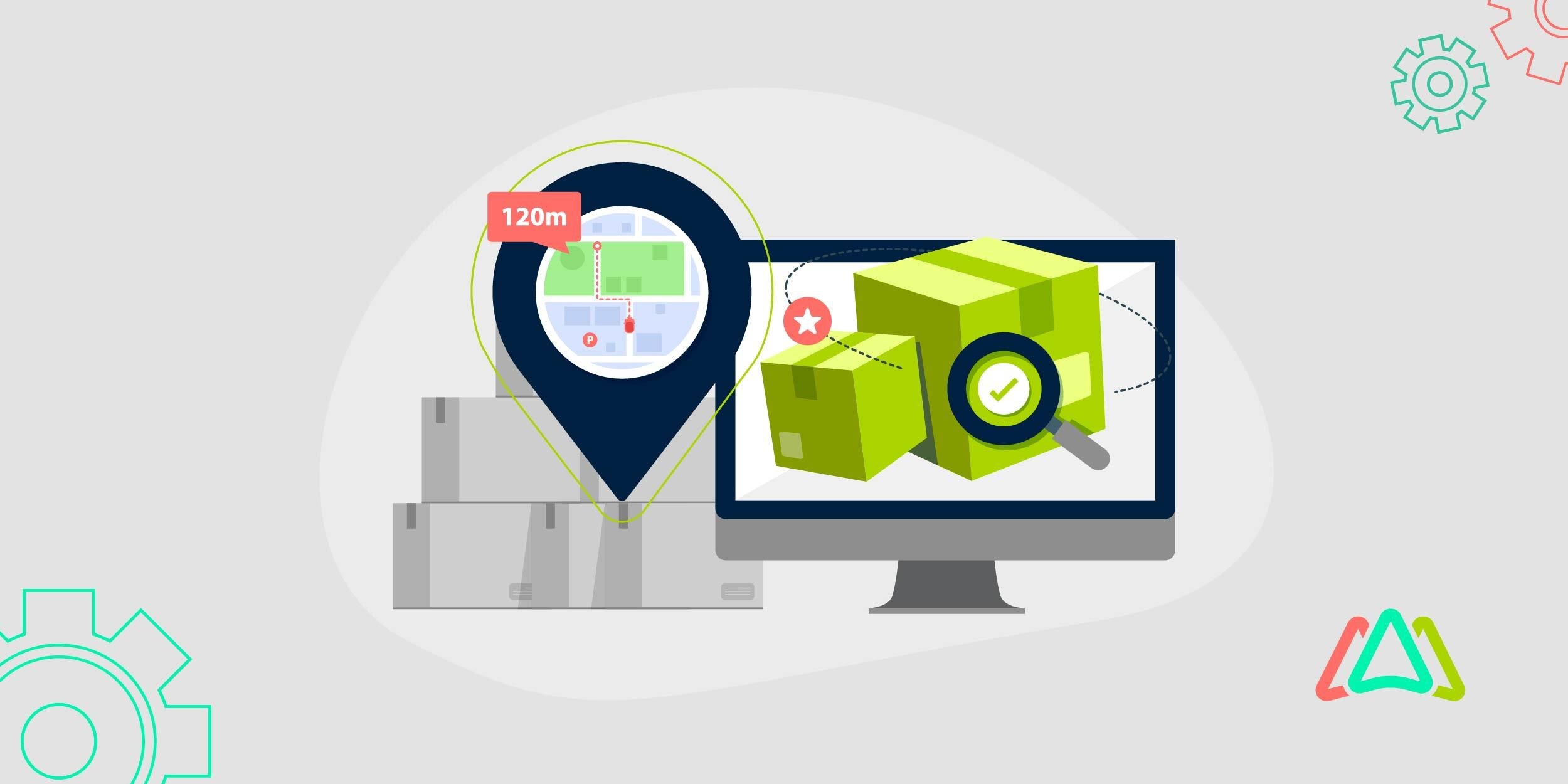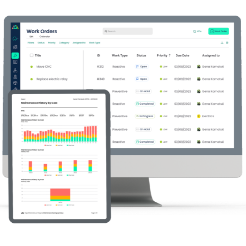
Using CMMS Software for Warehouse Management
Modern warehouses are instrumental to maintaining the smooth operations of supply chains, ensuring the efficient flow of goods from production to customers and consumers. Beyond their logistical efficiency, these facilities depend on the proper management of equipment, infrastructure, and systems, all of which require routine maintenance to ensure reliable operation. Consequently, an increasing number of warehouse managers and operators are adopting computerized maintenance management systems (CMMS) to effectively manage this critical aspect of their operations.
A CMMS is a software solution that centralizes, automates, and streamlines maintenance management processes. The software enables warehouse teams to track assets, manage work orders, schedule preventive maintenance, monitor spare parts inventory, and generate detailed and actionable reports—all from a single, centralized platform. When it comes to warehousing, CMMS software helps warehouse facilities reduce unplanned downtime, improve equipment reliability, and ensure safety and compliance. It does all this while keeping operational costs in check.

When it comes to warehouse operations, where a malfunctioning forklift, conveyor belt, or HVAC system can result in delayed orders or compromised safety, the challenge of preventing such incidents is front and center. While manual or reactive maintenance were once considered standard approaches to maintenance management, over time, they proved to be less than optimal because they often led to breakdowns, missed inspections, and costly repairs. In contrast, a CMMS allows warehouse teams to adopt a proactive and data-driven maintenance strategy, ensuring smoother operations and fewer disruptions.
Additionally, as warehouses increasingly adopt Industry 4.0 technologies, such as IoT-enabled sensors, robotics, and real-time inventory tracking, CMMSs have responded by integrating these maintenance tools into their functionality. The result is that a modern CMMS doesn’t just replace spreadsheets or paper checklists.
This article explores how CMMS software supports warehouse operations by highlighting key features to look for, providing implementation tips, and outlining what to consider when selecting a maintenance solution.
Key Benefits of Warehouse CMMS
While a warehouse CMMS offers several benefits, the one that is most immediate and visible is its ability to increase uptime and productivity. A CMMS does this by enabling maintenance and facilities management teams to submit, assign, and complete maintenance work orders quickly, often right from a mobile device. With these capabilities, a CMMS can reduce delays caused by paperwork or miscommunication, thereby enhancing overall efficiency. Additionally, maintenance technicians and operators can access equipment manuals, maintenance records, and accurate maintenance procedures from anywhere, thus reducing diagnostic time and speeding up repairs. Utilizing features like QR code scanning further streamlines access to asset history and instructions, allowing warehouse operations to stay on schedule with minimal interruptions.
Another key benefit is CMMS’s ability to establish a preventive maintenance (PM) program, rather than relying solely on reactive repairs. Warehouses often operate high-utilization equipment, such as forklifts, conveyors, and climate control systems, that require routine servicing to prevent breakdowns. A CMMS helps schedule preventive maintenance tasks based on calendar dates, usage, or condition-based triggers. Using this structured approach not only extends the lifespan of critical assets but also prevents unexpected failures that can bottleneck the flow of goods. Implementing a solid preventive maintenance plan can significantly reduce unplanned downtime and emergency repair costs.
Regulatory compliance and audit readiness are additional areas where warehouse CMMS software shines. Whether it’s food safety standards, environmental regulations, or health and safety inspections, warehouses are required to demonstrate that their equipment is regularly inspected, calibrated, and properly maintained. CMMS software has the ability to automate this process by keeping digital records of completed tasks, technician sign-offs, and asset histories. With its built-in dashboards and reporting tools, a CMMS makes it easy to generate compliance documentation or respond to auditor requests without having to scramble for paper files or spreadsheets.
Finally, a CMMS facilitates informed decision-making through its comprehensive analytics and reporting capabilities. Warehouse managers can track key performance indicators (KPIs) such as maintenance costs, response times, mean time between failures (MTBF), and equipment downtime. These critical insights facilitate the identification of inefficiencies, the justification of budget increases, and the support of capital investment decisions. For example, suppose the CMMS data indicates that a particular asset frequently fails and consumes excessive maintenance resources. In that case, maintenance managers can make an informed decision to repair, replace, or upgrade the asset. Over time, this level of visibility supports a more cost-effective and adaptable warehouse operation.
Core CMMS Features for Warehouse Operations
The strength of CMMS software lies in providing comprehensive asset management. This core feature allows maintenance teams to catalog and monitor all physical assets. Each asset record includes specifications, service history, manuals, and parts lists. With this centralized data, technicians can quickly gain access to an asset’s background and requirements, which not only speeds up repairs but also supports more innovative preventive maintenance planning. For warehouses managing hundreds or thousands of assets, this level of organization can significantly reduce downtime and human error.

Another key CMMS feature is work order management. Maintenance managers and technicians can easily create, assign, and track work orders in real time. Using this function, technicians receive clear instructions, due dates, and associated procedure checklists for the work order. They can also log time, parts used, and detailed notes, and capture images directly into the system from a mobile device. This streamlined process eliminates the inefficiencies of paper-based tracking, helps prioritize urgent issues, and ensures no maintenance task falls through the cracks. Over time, the data collected from work orders builds a complete history that can inform future decisions and identify recurring problems.
The addition of mobile functionality to CMMSs has become a game-changer. This feature has proved invaluable in a warehouse setting where maintenance teams are constantly on the move. A mobile-enabled CMMS allows technicians to receive alerts, access asset records, update work orders, and even scan QR or barcodes without having to wait to enter them into a desktop computer. This not only improves response times and communication but also enhances accuracy, since updates are logged in real-time.
Finally, inventory and spare parts management is a crucial yet often overlooked feature in warehouse CMMS solutions. With its built-in inventory tracking capabilities, teams can monitor parts usage, track reorder points, and avoid stockouts that delay repairs. The CMMS can also anticipate future needs based on usage trends and upcoming maintenance schedules. In doing so, the system helps optimize inventory levels and reduce carrying costs. In advanced CMMS systems, parts can even be automatically allocated to specific work orders or linked to asset types. This added capability makes it easier for teams to find and use the correct materials for each job.
Implementation & Onboarding
As is true when adopting any new software or tool, the implementation and onboarding processes are crucial. When implementing a CMMS in a warehouse environment, having a clear and structured onboarding plan is essential. This typically begins by identifying the goals of the implementation, which should be considered during the purchasing phase as well. Whether it's reducing downtime, improving compliance, or gaining better control over assets and inventory, these issues need to be discussed and planned for. The next step is defining the scope of the system: assets will be tracked, system access, facilities or zones within the warehouse to be included. The final step in the implementation process involves importing asset and parts data, mapping warehouse locations, and classifying equipment into categories.
Once the data is imported, CMMS admin users can tweak settings and configurations so that workflows are optimized and set to meet the specific needs of the warehouse operations. A good CMMS should be flexible enough to align with your existing workflows while offering opportunities for process improvement. This should be a key consideration when selecting a CMMS solution for larger, more complex warehouse operations. When it comes to customizing preventive maintenance schedules, several options are available, including manufacturer recommendations, usage data, and seasonal patterns. Other customization options enable the creation of user roles with different permissions, as well as the setting of alerts and notifications to notify the relevant individuals at the appropriate times when a task is due, overdue, or completed.
A successful implementation is more likely when practical training and change management are considered a priority. Failing to address the need for user education and training can impede the adoption of a CMMS. Training should be hands-on and role-specific. Providing job aids, short video tutorials, and ongoing support helps reinforce learning and retention. These, along with a demonstrated buy-in from leadership, can also help overcome team members’ resistance to change.
Ultimately, ongoing support and system optimization are crucial for achieving long-term success using a CMMS. Even after the initial implementation, it's recommended that users receive periodic refresher training, especially as new features are rolled out or processes evolve. Many CMMS providers offer ongoing customer support, help centers, community forums, and knowledge bases to assist teams in troubleshooting issues and learning best practices. As a warehouse grows or its needs change, revisiting the system setup is advisable to ensure the CMMS continues to deliver value over time.
Choosing the Right CMMS for Your Warehouse
Selecting the right CMMS for your warehouse requires more than just comparing features; it’s about finding a solution that aligns with your team’s needs, scale, and long-term objectives. A recommended starting point is identifying the must-have features that support your daily operations. For most warehouses, these include robust asset and work order management, mobile accessibility, preventive maintenance scheduling, inventory tracking, and reporting tools. An intuitive interface is also important; if it's overly complex or confusing, user adoption will suffer, regardless of the system's capabilities. Additionally, ensure the CMMS can scale with your business, whether you operate a single warehouse or manage multiple facilities across regions if necessary.
Beyond features, seriously consider the vendor’s industry experience and support structure. A provider with a proven track record in warehouse or logistics environments is more likely to understand your unique challenges and offer relevant templates, workflows, and best practices. Seek out vendors that provide comprehensive onboarding, easily accessible training resources, and prompt customer support. Take the time to understand a vendor’s pricing model—some CMMS platforms charge per user, while others offer flexible plans based on the number of assets or facilities. One may appear to be a deal, but may not be once you determine what a vendor’s all-in price is. Requesting a free trial or live demo can help you evaluate whether the software fits seamlessly into your existing operations before making a long-term commitment.
Conclusion
High-volume warehouse environments depend on equipment reliability, efficient workflows, and regulatory compliance; these factors are non-negotiable. A modern CMMS can meet these challenges by enabling warehouse teams to transition from reactive to proactive maintenance, minimize costly downtime, streamline inspections, and make informed, data-driven decisions. With capabilities that include asset management, inventory control, real-time analytics and reports, and compliance audits, the right CMMS has the capability of maintaining operational excellence. As warehouses face increasing pressure to move faster and better while keeping costs in check, a CMMS is no longer a nice add-on, it’s a strategic operations necessity.
TABLE OF CONTENTS
Keep Reading
The longest U.S. federal government shutdown to date lasted 43 days, beginning on October 1, ...
5 Dec 2025
Every maintenance professional faces it sooner or later — that critical time when an aging ...
18 Nov 2025
The term 'best' is often used loosely, without a clear understanding of its context or ...
14 Nov 2025
In the not too distant past, maintenance strategies have been defined by reaction—fixing ...
13 Nov 2025
Tax season is the time of year that often sends a ripple of anxiety through many of us. The ...
11 Nov 2025
Selecting a Computerized Maintenance Management System (CMMS) can, at first glance, be an ...
4 Nov 2025
In healthcare facilities, equipment uptime involves more than achieving operational ...
31 Oct 2025
Companies are subject to economic ups and downs, also known as economic volatility. Today, ...
30 Oct 2025
Maintenance challenges are a constant struggle, with unplanned downtime costing manufacturers ...
27 Oct 2025
Last winter, a maintenance technician at a U.S. paper mill ignored a predictive alert that ...
10 Oct 2025
Many organizations proudly say they “have a CMMS,” but ownership alone doesn’t equal ...
9 Oct 2025
Every maintenance team is under pressure to do more with less. Unplanned downtime is often ...
7 Oct 2025
The implementation of simple, yet powerfully effective, checklists has repeatedly ...
3 Oct 2025
In manufacturing, every second counts. When production stops, whether due to scheduled ...
2 Oct 2025
The increasing cost of maintenance, lack of accountability, and siloed systems leave many ...
30 Sep 2025
Preventive maintenance is one of those things maintenance teams know they need to do, but it ...
26 Sep 2025
Public services are essential to daily life. The provision of safe roads, functional transit, ...
25 Sep 2025
For most manufacturing facilities, a major focus of their maintenance teams revolves around ...
24 Sep 2025
Have you ever tried explaining to the CEO why the production line has been down for hours ...
18 Sep 2025
Over the past few decades, the hotel industry has undergone a dramatic transformation. ...
16 Sep 2025





